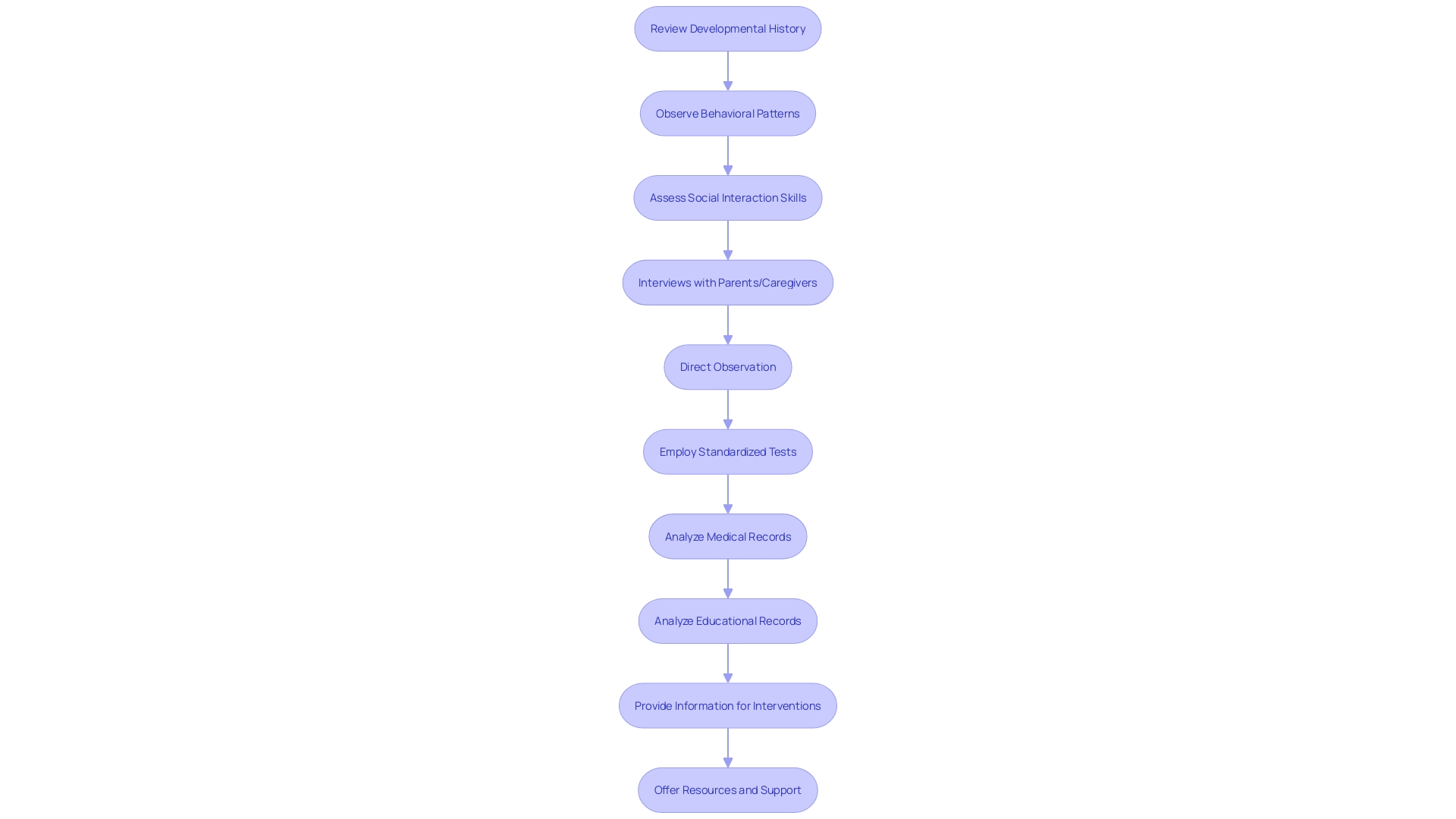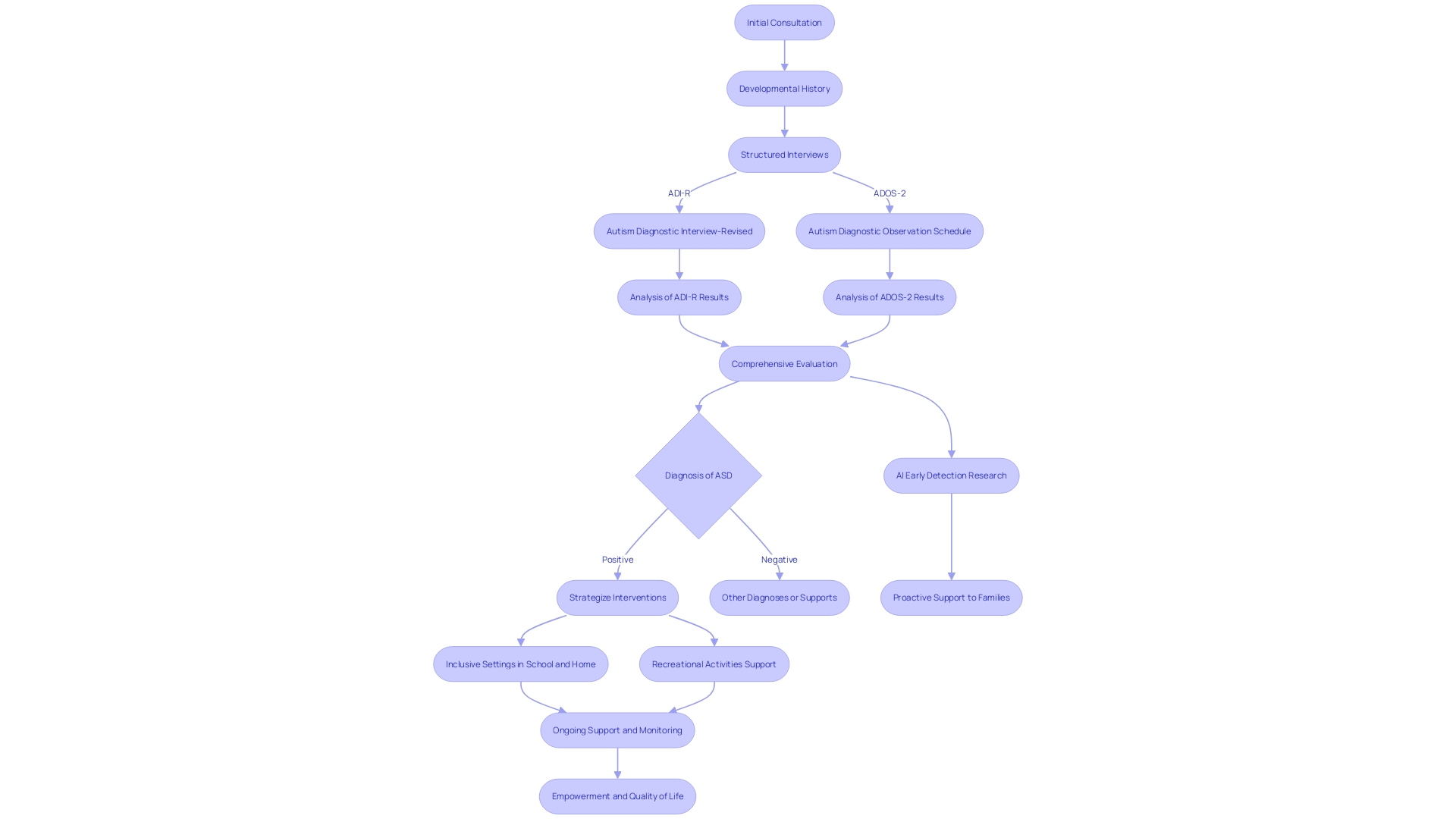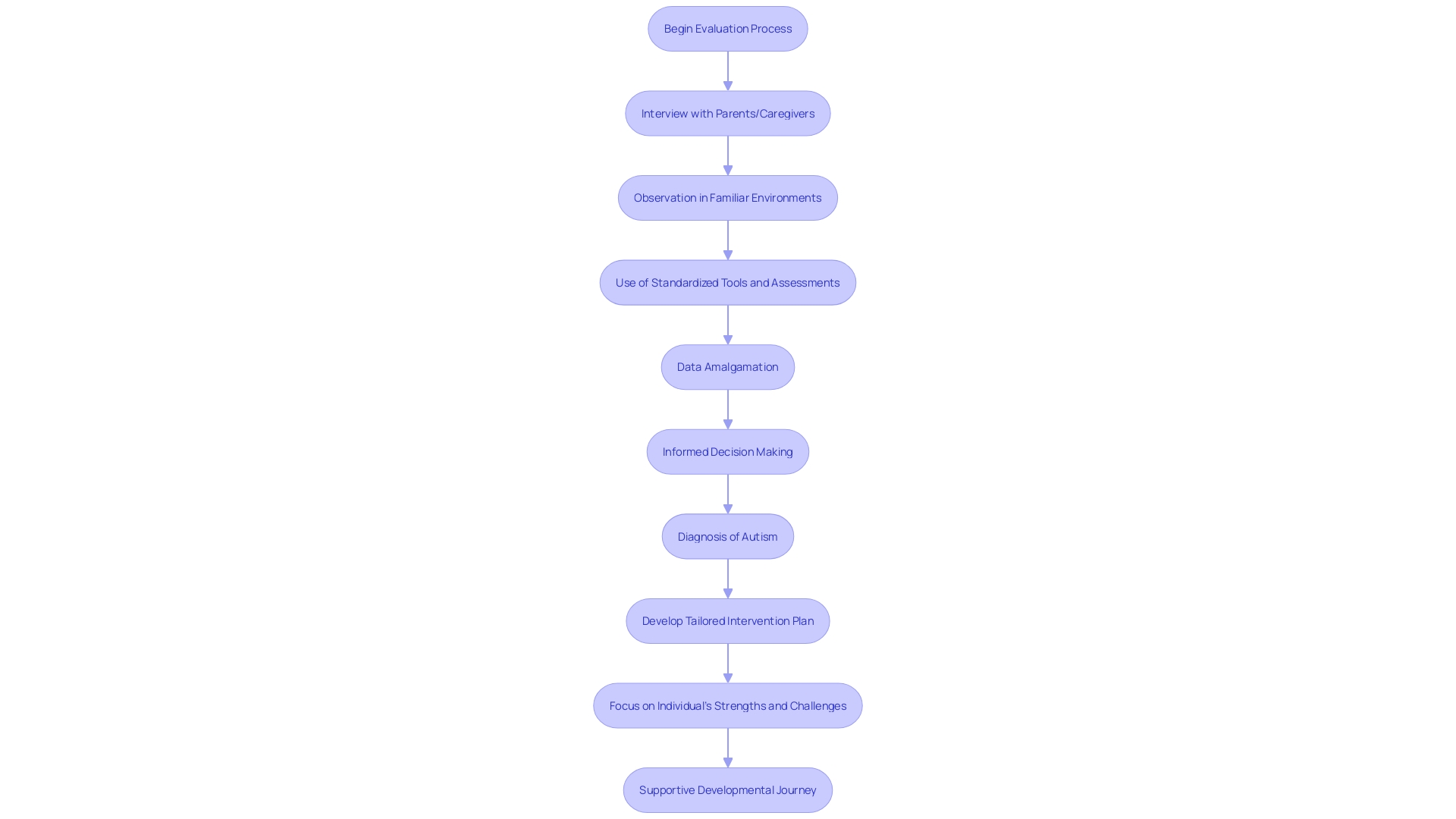Introduction
The evaluation process for Autism Spectrum Disorder (ASD) is a meticulous multi-faceted assessment designed to discern if a child aligns with the criteria for ASD. This process is not a single test, but a suite of evaluations that encompasses several integral components. It includes a thorough review of the child's developmental history, detailed observation of behavioral patterns, and assessment of social interaction skills.
Professionals may conduct interviews with parents or caregivers, engage in direct observation of the child, and employ standardized tests to gauge certain behaviors and abilities.
Crucially, an autism evaluation is also informed by the analysis of medical and educational records. This comprehensive approach ensures that each aspect of the child's development and environment is considered, providing a rich, multidimensional picture of the child's unique strengths and challenges. The goal is to equip caregivers and healthcare providers with crucial information, supporting the child's journey with tailored interventions and resources that foster their well-being and development.
Components of an Autism Evaluation
The evaluation process for Autism Spectrum Disorder (ASD) is a meticulous multi-faceted assessment designed to discern if an individual aligns with the criteria for ASD. This process is not a single test, but a suite of evaluations that encompasses several integral components. It includes a comprehensive review of the individual's developmental history, detailed observation of behavioral patterns, and assessment of social interaction skills. Professionals may conduct interviews with parents or caregivers, engage in direct observation of the individual, and employ standardized tests to gauge certain behaviors and abilities.
Crucially, an autism evaluation is also informed by the analysis of medical and educational records. This comprehensive approach ensures that each aspect of the individual's development and environment is considered, providing a rich, multidimensional picture of the individual's unique strengths and challenges. The aim is to provide caregivers and healthcare providers with vital information, supporting the journey of the individual with customized interventions and resources that promote their well-being and development.

Screening Tools for Autism
Autism spectrum disorder (ASD) is characterized by challenges with social skills, repetitive behaviors, and communication difficulties. Early detection is crucial as it opens the door to early intervention, which can significantly improve outcomes. In order to achieve this goal, screening instruments are extremely valuable in identifying individuals who may be at risk for a specific developmental disorder, justifying the need for additional evaluation. These tools are specifically designed to swiftly gauge a child's development, particularly in areas commonly affected by ASD.
The Modified Checklist for Autism in Toddlers (M-CHAT) and the Social Communication Questionnaire (SCQ) are among the widely utilized screening instruments. They serve as an initial step, providing indicators of potential developmental disorder, thereby enabling healthcare professionals to make informed decisions about the necessity for a comprehensive diagnostic evaluation. Notably, advancements in technology are enhancing the efficacy of these tools. For example, the Sense to know app, created by specialists at Duke University, utilizes visual stimuli on tablets to assess a variety of behavioral responses that suggest a certain developmental disorder. This novel method employs AI algorithms to analyze the data, providing a quantitative measure of the probability of an ASD assessment.
Furthermore, research highlights the importance of incorporating screening for autism spectrum disorder into routine healthcare. This integration facilitates prompt referrals for additional evaluations when necessary, as demonstrated by the Get SET Early model. In a study involving 203 pediatricians in San Diego County, this model standardized the screening process during well-child visits and provided digital platforms for immediate result scoring. The result was a higher rate of referrals and faster progression from screening to evaluation and services, confirming that the identification of individuals with autism can indeed occur as soon as 12 to 14 months, which is significantly sooner than the average age of diagnosis in the country.
This emphasis on early detection and intervention is echoed by organizations like The Autism Community in Action (TACA), which underscores the treatable nature of autism and the profound impact of early therapeutic interventions. With the appropriate tools and a dedication to fair healthcare practices, as supported by the US Preventive Services Task Force, we can guarantee that every individual, including those with ASD, has an equal opportunity in the 'race' of development and integration into society.

Diagnostic Evaluation Process
A comprehensive diagnostic evaluation is key in identifying Autism Spectrum Disorder (ASD) and involves a team of multidisciplinary professionals. These experts, including psychologists, psychiatrists, and developmental pediatricians, conduct a multi-faceted assessment. The evaluation includes a detailed review of the child's developmental history, discussions with parents or caregivers, direct behavioral observations, and the use of standardized tools like the DSM-5. Such meticulous assessments are crucial, as ASD is a spectrum condition that manifests differently across individuals. It's crucial to mention that an official determination is not always required for one to recognize oneself as autistic, as self-identification is acknowledged within the autistic and neurodivergent community. This is particularly relevant when considering the challenges and potential inconclusive results that can arise from medical testing. In addition, clinicians cannot directly identify a specific condition through medical tests; instead, they rely on observed behaviors and developmental history to arrive at a conclusion. Research shows that brain scans of individuals with autism often reveal variations in brain structure compared to neurotypical development, supporting the understanding that autism has a genetic basis. Prompt and precise identification is crucial, as it unlocks the opportunity for timely intervention, which can greatly enhance results. Current diagnostic methods may be too late or ineffective for some, emphasizing the need for tools that can identify ASD as early as possible. The need to close this void in diagnostic technology is being tackled by organizations such as NeuroQure, with the goal of assisting families shortly after childbirth and minimizing the typically lengthy process of identifying ASD.
Diagnostic Tools and Instruments
The process of evaluating an individual for autism spectrum disorder (ASD) is comprehensive, utilizing a range of tools to ensure an accurate diagnosis. Structured interviews, such as the Autism Diagnostic Interview-Revised (ADI-R), are instrumental in this process. By exploring the social interactions, communication abilities, and patterns of behavior of the individual, these interviews offer valuable insights. On the observational side, the Autism Diagnostic Observation Schedule (ADOS-2) allows professionals to witness the individual's behavior within a controlled environment, offering another dimension of understanding. These methods are crucial not just for identification but also for strategizing impactful measures, which, when implemented at an initial stage, have been proven to greatly improve results for children with ASD.
In the pursuit of prompt and efficient identification, there is a continuous endeavor to close the distance between the requirement and the accessibility of diagnostic instruments. Innovations such as artificial intelligence (AI) are showing promise in identifying ASD sooner, which can be a game-changer for intervention strategies. With such advancements, the possibility of providing support to families mere weeks after birth is on the horizon, aiming to alleviate the often protracted journey towards diagnosis. This proactive approach is essential, particularly for families with a history of ASD, where early detection can result in significantly enhanced life trajectories for children.
The shared objective is to guarantee that every individual, irrespective of their abilities, can fully engage in the essential areas of school, home, and recreational activities—a vision echoed by the words of Dr. David (Dan) R. Offord, 'I do not mind if my offspring are in a race as long as the race is fair.' By acknowledging the distinct requirements and capabilities of individuals with ASD, offering essential support to their guardians, and minimizing sources of tension, we can cultivate an inclusive setting where all individuals can flourish.

The Role of Comprehensive Needs Assessment
Designing a customized intervention plan for an individual with autism spectrum disorder (ASD) relies on a thorough needs assessment. This process explores the abilities and areas requiring support of the individual, including communication, social interaction, behavior, and educational needs. By synthesizing information from a constellation of sources—parents, educators, therapists, and other professionals who work with the child—this assessment forms the cornerstone of a personalized support strategy. It's not merely about identifying challenges; it's about recognizing the child's inherent strengths and leveraging them to facilitate growth and learning.
Amidst this, it's crucial to acknowledge the broader context. With only about 3 in 10 autistic individuals in the workforce, compared to 8 in 10 non-disabled people, the need for effective early intervention and support is stark. Empowering individuals with autism through education and employment remains a pressing challenge, as evidenced by the significant pay gap they face—the largest among all disability groups. By implementing comprehensive assessments and transition services, tailored to each child's unique profile and future goals, we not only help them navigate their immediate environment but also lay the groundwork for their eventual transition into the workforce and independent living. Additionally, as the Interagency Autism Coordinating Committee (IACC) and organizations such as The Autism Community in Action (TACA) promote, timely and precise identification combined with behavioral therapy can significantly enhance results, emphasizing the significance of comprehensive and considerate evaluation procedures.
Importance of Early Diagnosis and Intervention
Autism Spectrum Disorder (ASD) is a complex developmental condition marked by challenges in social interaction, communication, and often includes repetitive behaviors. The path to unveiling the first indicators of ASD is becoming clearer as researchers like Naviaux uncover the intricate interplay of genetic and environmental factors that contribute to the onset of symptoms. With this comprehension comes the potent chance for diagnosis in advance, which accelerates the potential for life-changing intervention in advance and maximizes the prospects for positive life trajectories.
During the crucial initial years, when the brain is highly adaptable, focused interventions such as speech, occupational, and behavioral therapies can greatly enhance the communication and social abilities of an individual, as well as enhance behavior management. For children diagnosed prior to the age of five, these interventions can be pivotal, yet statistics show that only a fraction—between 10-20 percent—of these children are likely to achieve a level of independence in adulthood. This emphasizes the significance of not just timely detection but also the accessibility and quality of subsequent support.
The consequences of missed or delayed support for individuals with autism spectrum disorder are stark; a report jointly produced by Child of the North and the Center for Young Lives warns of a crisis in the evaluation of individuals with autism spectrum disorder. Lengthy waits for health and education support can lead to exacerbated mental health issues, increased risk of school exclusion, and hindered academic achievement. The report supports a strategy that prioritizes timely identification and the provision of effective support without solely depending on a formal determination.
Amidst these challenges, there is hope on the horizon. Innovations in artificial intelligence, as emphasized in a study by Leigh Hopper from the University of Southern California, show promise in aiding the diagnosis of autism. This technological advancement stands to be a game-changer, potentially streamlining the path to early intervention and tailoring it to each individual's unique needs. As we embrace these advancements, ensuring equitable access to resources and support remains paramount, as every individual deserves the chance to thrive in a 'fair race' of development and opportunity.
Common Diagnostic Tools: ADOS-2, M-CHAT, and DSM-5
The journey to understanding and supporting an individual who may be on the spectrum of autism is crucial, and it begins with a robust diagnostic framework. The Autism Diagnostic Observation Schedule, Second Edition (ADOS-2) is a highly regarded instrument that clinicians utilize for direct observation of social interaction, communication, play, and imaginative use of materials. It enables an organized setting where the behaviors of youngsters can be assessed to provide information. For younger children, early identification is pivotal, and the Modified Checklist for Autism in Toddlers (M-CHAT) serves as an essential preliminary screening tool to detect early signs of autism spectrum disorders.
Moreover, the Diagnostic and Statistical Manual of Mental Disorders, Fifth Edition (DSM-5), provides clinicians with extensive criteria to differentiate Autism Spectrum Disorder (ASD), ensuring a dependable and standardized approach to identification. The DSM-5's guidelines are instrumental in equipping professionals with the necessary framework to provide an accurate assessment. This is crucial as research, including insights from the National Academies of Sciences, Engineering, and Medicine, emphasizes the significance of intervention at a young age. By identifying the condition promptly and accurately, young individuals can start obtaining the assistance and treatment necessary, which can greatly enhance their future results.
In the context of advancing diagnostic methods, AI technology and innovative approaches are being explored to improve early detection and treatment strategies. The Autism Community in Action (TACA) and organizations like NeuroQure are at the forefront, demonstrating the profound impact that timely intervention can have. As scientific advancements continue, the incorporation of consensus based on evidence and the most recent scientific discoveries will persistently mold the future of diagnosis and intervention for individuals affected by autism, ultimately bringing significant advantages to individuals and their families.
What to Expect During an Autism Evaluation
The evaluation process for autism is a complex journey that requires a collaborative approach to comprehending the distinctive profile of each individual. It includes a series of interviews with parents or primary caregivers, which are crucial to outline the individual's developmental milestones, behavioral patterns, and the specific challenges they face. These discussions are crucial as they establish the foundation for professionals to understand the context of the individual's experiences.
Throughout the assessment, youngsters are observed in recognizable environments, like their homes or educational settings. This real-world observation is critical to discern how they interact and respond to everyday stimuli. Standardized tools and assessments are also employed to meticulously evaluate aspects of communication, social interaction, and any repetitive behaviors. These instruments are designed with the objective of capturing a comprehensive picture of the individual's abilities and areas requiring support.
The ultimate aim of this thorough evaluation process is not just to arrive at a diagnosis but to carve out a tailored intervention plan that accentuates the individual's strengths while addressing their challenges. This strategy aligns with the insights shared by experts in the field who emphasize the importance of quality and respect in intervention research for autism. By amalgamating data from various sources, including the most recent studies and reports, professionals are equipped to make informed decisions that respect the individuality of each child and uphold their right to a supportive and enriching developmental journey.

Conclusion
In conclusion, the evaluation process for Autism Spectrum Disorder (ASD) involves a thorough assessment of a child's developmental history, behavioral patterns, and social interaction skills. Screening tools and advancements in technology aid in early detection and diagnosis, allowing for timely intervention.
A multidisciplinary team conducts a comprehensive evaluation, utilizing tools like the ADI-R and ADOS-2 to inform diagnosis and intervention planning. Efforts are underway to improve diagnostic technology and provide support to families soon after birth.
Tailored intervention plans based on comprehensive needs assessments are crucial for supporting children with ASD. Early intervention and support empower individuals, enhancing their prospects for education and employment.
Early diagnosis is pivotal, as it enables targeted interventions during the critical early years. However, accessing timely support remains a challenge. Innovations in AI show promise in aiding early diagnosis, but equitable access to resources and support is essential.
In summary, the evaluation process for ASD is comprehensive, focusing on various aspects of a child's development. Early detection and intervention are key to improving outcomes. Tailored intervention plans, comprehensive assessments, and support services empower individuals with ASD.
By recognizing their unique needs and providing necessary resources, we can foster an equitable environment where all children can thrive.




